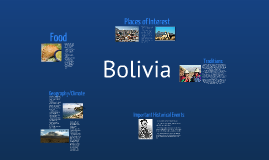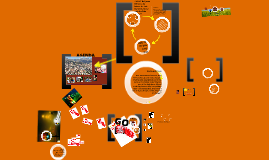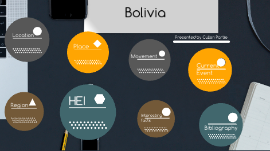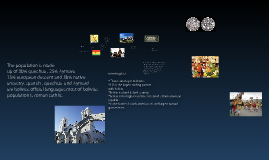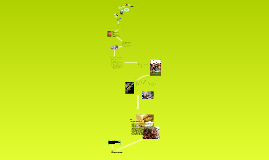Bolivia
Transcript: Bolivia This is the flag of bolivia. The red on the Bolivian flag represents the bravery of the Bolivian soldier. The green symbolizes the fertility of the land The yellow represents the country's mineral resources. Enclaustramiento geográfico de Bolivia es igual al tamaño de California y Texas. Brasil forma su frontera oriental, con sus demás vecinos son Perú y Chile en el oeste y Argentina y Paraguay en el sur. Encima de Bolivia Chile y Perú Capital - La Paz What are the major cities of Bolivia? When we talk about the main cities of a country we’re usually referring to the cities with the largest populations. Santa Cruz Cochabamba Potosí Natural sources and exports • Export goods include natural gas soybeans soy products crude petroleum zinc ore tin. • Bolivia is known for having cocoa. Tourism The city of La Paz is one of the top tourist attractions in Bolivia. La Paz sits in the Andes Mountain range and is the world's highest capital. The city is the most popular place to visit in Bolivia. Lake Titicaca sits in the Andean Mountain region and is one of the highest lakes in the world. The lake is one of the most sacred and mystical places in all of South America, where you'll find ancient Inca ruins. Copacabana about a 3 hours drive from La Paz, this town sits on the southern shores of Lake Titicaca. Copacabana offers many attractions. Government & History The goverment is Republic History Famous since Spanish colonial days for its mineral wealth, modern Bolivia was once a part of the ancient Inca empire. After the Spaniards defeated the Incas in the 16th century, Bolivia's predominantly. Indian population was reduced to slavery. The remoteness of the Andes helped protect the Bolivian Indians from the European diseases that decimated other South American Indians. By the end of the 17th century, the mineral wealth had begun to dry up. The country won its independence in 1825 and was named after Simon Bolivar, the famous liberator. Ethnics & religion Ethnic Groups: Quechua 30%, (mixed white and Amerindian ancestry) 30% Aymara 25% white 15% Religion: Roman Catholic 95% Protestant 5% • . Most Bolivians are born into Roman Catholicism. • . Religion tends to be a female dominated activity in terms of attending church and the like. Language Spanish is the main and official language of Bolivia.However there are some 39 other living languages used in the country spoken by people in different regions. Examples: • Aymara • Some 50% of the population have an indigenous language as their mother tongue. • The currency of Bolivia is known as the Boliviano (BOB) Meeting & Greeting The handshake is the most common form of greeting. People with an informal relationship will be warmer and embrace or pat each other on the shoulder. Women will kiss on the cheek. Bolivians use both their maternal and paternal surnames. The father's surname is listed first and is the one used in conversation. Direct eye contact is also usual. When meeting people will use the most appropriate greeting for the time of day When a woman gets married she usually adds her husband's first surname to her first surname with the connector "de", so if Jennifer Maria Lopez marries Manuel Sebastien Costa, she would be called Jennifer Maria de Costa. Sports Bolivia soccer is like a religion. Fans frequently get into physical altercations over this sport. Soccer is Bolivia's national past time. Music Out of all the Andean countries, Bolivia remains perhaps the most culturally linked to the indigenous peoples. Like most of its neighbors, Bolivia was long-dominated by Spain and its culture. Even after independence, Bolivian music was largely based on European forms. In1952, a revolution established nationalistic reforms granting increased social, cultural and political awareness for the Aymara and Quechua natives. The most common musical instruments are: sicu or zampoña quena tarka or tarqa pinkillo skin drums copper bells Food Some popular food dishes are: Humitas - Fresh corn with cheese wrapped in corn leaves and steamed. Lechon - Roast suckling pig. Charque de llama - Dried llama meat, fried, served with stewed corn, hard cooked eggs and cheese. Chicharron - Pieces of fried pork, cooked with chicha Changa de pollo o de conejo - Soup make with chicken or cuy (guinea pig), potato, peas, avas and green onion. Saltenas - Only eaten in the morning. A warm savory pastry that holds a juicy combination of chicken or meat, greens and sauce, and is cooked in an oven. fin. gracias por escuchar! Currany http://www.lonelyplanet.com/bolivia Los colores de la bandera son: rojo amarillo verde http://www.infoplease.com/ipa/A0107345.html http://www.state.gov/r/pa/ei/bgn/35751.htm http://google/images.com Cities






